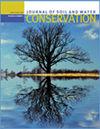比较地下排水装置对土壤物理和生物特性的短期和长期影响
IF 2.6
4区 农林科学
Q2 ECOLOGY
引用次数: 0
摘要
地下排水是一种常用的做法,用于支持农业生产和提高排水不良土壤的产量。经过几十年的地下排水装置,农田往往增加了水的排放和养分的损失。然而,很少有研究评估土壤性质或土壤健康指标在地下排水不同年龄的变化。在这项研究中,我们试图量化土壤性质随时间的变化。为了实现这一目标,我们对明尼苏达州西北部的六个油田进行了采样,代表两个时间尺度:三个油田在采样前排水超过15年(即2006年之前安装的地下排水系统),三个油田在采样后5年内排水(即2016年之后安装的地下排水系统)。我们评估了三种土壤物理特性:饱和导电性(Kfs)、体积密度和团聚体稳定性,以及0至15厘米和15至30厘米土壤健康指标:水可提取有机碳(WEOC)和氮(WEON),以及潜在矿化碳(PMC)。排水系统较旧的田具有较大的Kfs、WEON(所有深度)、WEOC (15 ~ 30 cm)和PMC (15 ~ 30 cm)。堆密度、团聚体稳定性、WEOC (0 ~ 15 cm)和PMC (0 ~ 15 cm)无显著差异。我们怀疑,Kfs的增加可能是在排水系统较旧的油田中进一步发展优先流动路径的结果。这些优先流动路径也可能是微生物多样性和活动增加的地区,在排水系统较旧的地区,生物指标较高。我们的研究结果表明,养分损失、土壤物理性质和土壤健康指标随着时间的推移而变化。这些指标应该作为排水研究的标准实践来跟踪,以提高我们对地下排水装置如何改变长期土壤特性的理解。这些知识将改善向种植者提供的信息,帮助他们更有效地管理土壤健康,减少养分流失到水道中。本文章由计算机程序翻译,如有差异,请以英文原文为准。
Comparing the short- and long-term impacts of subsurface drainage installation on soil physical and biological properties
Subsurface drainage is a common practice used to support agricultural production and increase yields in poorly drained soils. Following decades of subsurface drainage installation, agricultural fields often have increased water discharge and nutrient losses. However, few studies have evaluated the changes in soil properties or soil health metrics at different ages of subsurface drainage. In this study, we attempt to quantify changes to soil properties over time. To achieve this, we sampled six fields in northwest Minnesota representing two timescales: three fields were drained more than 15 years prior to sampling (i.e., subsurface drainage installed prior to 2006), and three fields were drained within 5 years of sampling (i.e., subsurface drainage installed after 2016). We evaluated three soil physical properties: saturated hydraulic conductivity (Kfs), bulk density, and aggregate stability, as well as three soil health metrics at 0 to 15 and 15 to 30 cm: water-extractable organic carbon (WEOC) and nitrogen (WEON), and potentially mineralizable carbon (PMC). The fields with older drainage systems had greater Kfs, WEON (all depths), WEOC (15 to 30 cm), and PMC (15 to 30 cm). There were no differences in bulk density, aggregate stability, WEOC (0 to 15 cm), and PMC (0 to 15 cm). We suspect that the increased Kfs is likely the result of further development of preferential flow pathways in fields with older drainage systems. These preferential flow paths could also be areas with increased microbial diversity and activity, indicated by the higher biological indicators in the fields with older drainage systems. Our findings suggest that nutrient losses, soil physical properties, and soil health metrics evolve over time. These metrics should be tracked as a standard practice in drainage research to improve our understanding of how subsurface drainage installation changes long-term soil properties. This knowledge will improve the information provided to growers and help them more effectively manage their soil’s health and reduce nutrient losses into waterways.
求助全文
通过发布文献求助,成功后即可免费获取论文全文。
去求助
来源期刊
CiteScore
4.10
自引率
2.60%
发文量
0
审稿时长
3.3 months
期刊介绍:
The Journal of Soil and Water Conservation (JSWC) is a multidisciplinary journal of natural resource conservation research, practice, policy, and perspectives. The journal has two sections: the A Section containing various departments and features, and the Research Section containing peer-reviewed research papers.

 求助内容:
求助内容: 应助结果提醒方式:
应助结果提醒方式:


